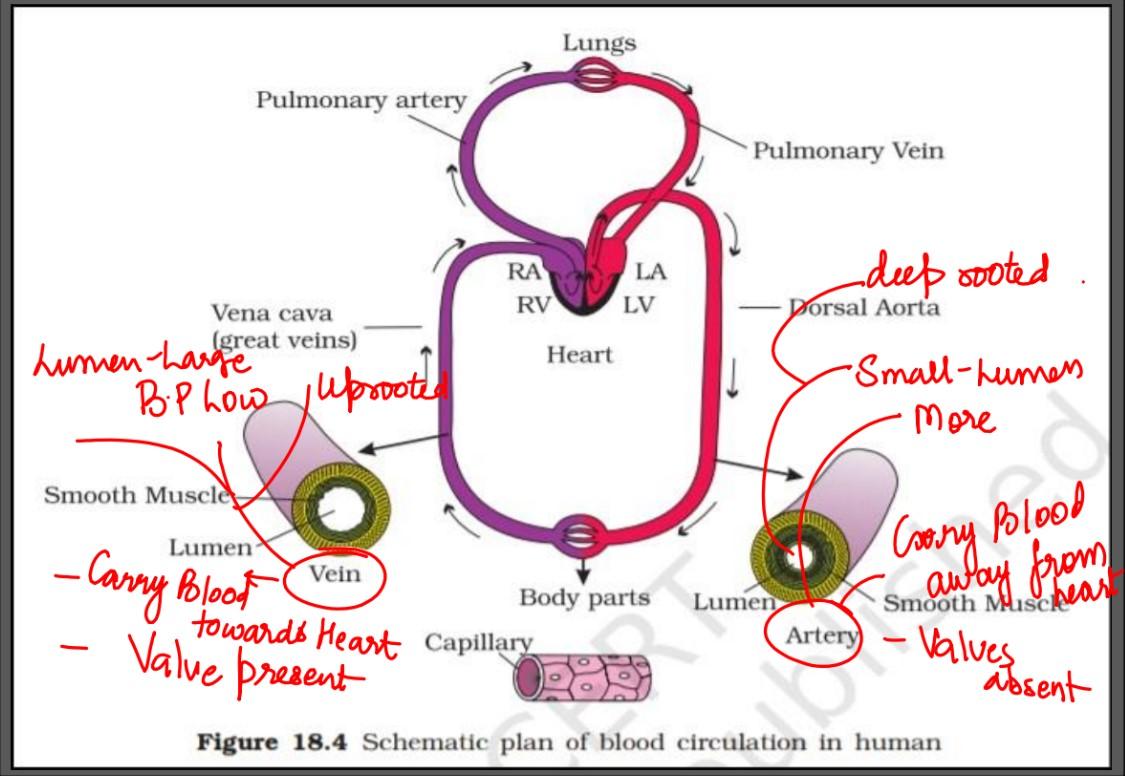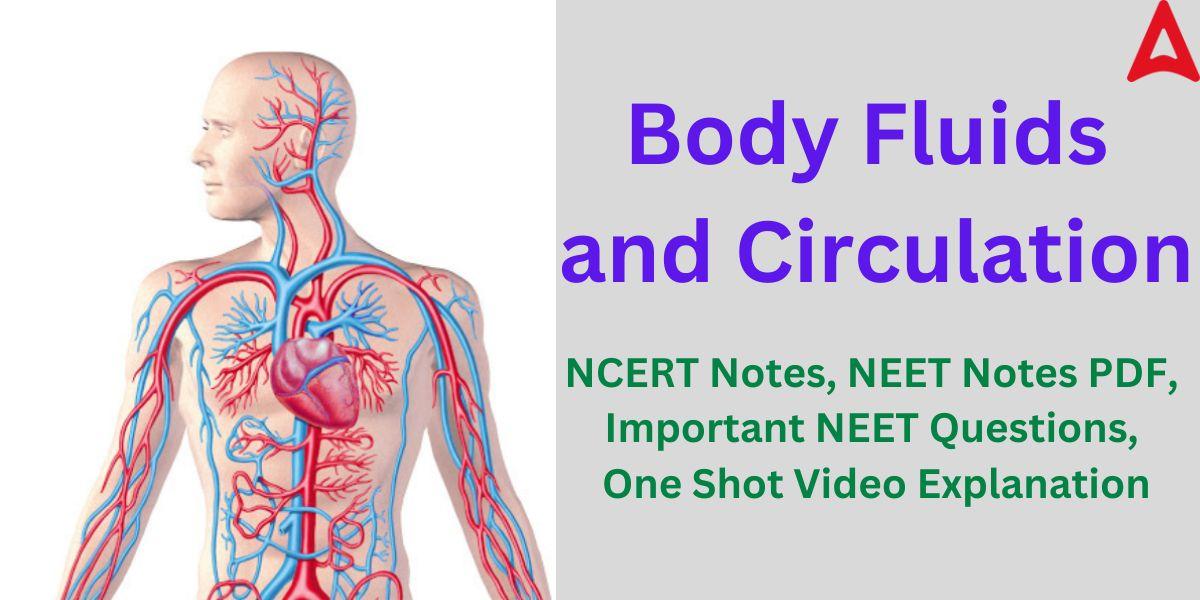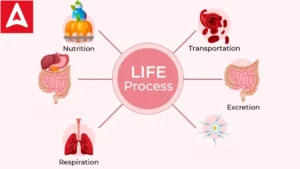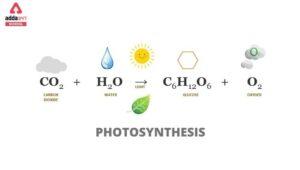Table of Contents
Body Fluids and Circulation: The chapter on body fluids & circulation holds important weightage both in the class 11th Biology examination and the NEET examination. Students must prepare this chapter properly to secure good marks in the NEET exam. This chapter deals with various body fluids found in the human body along with their circulation process. If you are looking for notes and video explanations of this chapter, then you are at the right place. In this article, we have compiled all the important notes of this chapter in a single PDF. You will also get the video explanation of this chapter here. This article will provide you with all the resources that will help you master this chapter.
Body Fluids and Circulation
Body Fluids and circulation chapter of Biology covers important topics like Human Heart, Blood, Lymph, Circulation Mechanism, Circulation disorders, etc. It is one of the most important concept in human physiology sub-section of Biology. The various kinds of liquids that are found inside the body are referred to as body fluids. These liquids usually circulate throughout the body or are eliminated from it. The cardiovascular system, which includes body fluids, is the human circulatory system. Together, they act as a conduit for the movement of vital materials like hormones, nutrients, and oxygen. This article will help you gain knowledge about the purpose and significance of body fluids in our system.
Body Fluids and Circulation Important Topics for NEET
The chapter of Body Fluids & Circulation is one of the most important chapters of the NEET biology section. Generally 3 questions are asked from this chapter every year in the NEET examination. Looking at its weightage, it is crucial to learn this chapter with complete dedication. By imbibing the concept of this chapter, you will confirm your 12 marks in NEET exam. As NEET exam has very high competition, every marks has a great influence on the rank of candidates. This article will provide you with expert notes based on latest NCERT syllabus which will help you ace this chapter with ease. Some of the important topics in this chapter are:
- Types of Body Fluid (Blood, Lymph, Composition of Blood)
- Circulation Mechanism (Open Circulatory System, Closed Circulatory System)
- Human Circulatory System (Heart, Arteries, Veins)
- Circulatory Disorders (Heart Failure, Angina, Heart Attack, Coronary Heart Disease)
Body Fluids and Circulation Class 11
The chapter of Body Fluids & Circulation falls under the Class 11th Biology syllabus. This concept is present in the 18th chapter of class 11 biology NCERT book. It is an important chapter of the human physiology. The class 11 NCERT chapter 18 deals with the important concept of circulation of nutrients and oxygen in our body along with the composition of two main fluids found in our body, that is blood and lymph. The NCERT Class 11 concepts of this chapter along with its video explanation is provided in this article at one place. The one one shot video explanation with notes in PDF format will make sure that you learn this chapter thoroughly for your board exams as well as NEET 2024 exam.
Body Fluids and Circulation Notes
The chapter on circulation and body fluids contain some important concepts for NEET exam. The same topics has been discussed below for the NEET aspirants.
Body Fluids
The two most significant body fluids in an individual are blood and lymph. Red blood cells, white blood cells, platelets, and plasma make up blood. Inside the lymphatic veins, a colorless fluid called lymph circulates.
Body Fluids Types
The two types of fluids found in human beings are given below with explanation.
1) Blood
Blood is the primary body fluid that is mainly responsible for the circulation of oxygen and nutrients in our body. Blood’s primary constituents are as follows:
- Plasma: Blood’s liquid component is called plasma. It is a viscous liquid that comprises 55% of the total volume of blood, with platelets, red blood cells, and white blood cells making up the remaining volume. Ninety-one percent of plasma is water, with the remaining portion consisting of waste materials, suspended proteins, dissolved gases, ions that have been dissolved, and nutritional molecules. The predominant protein in plasma is albumin. Clotting factors and immunoglobulins are examples of additional proteins.
- Red Blood Cells: Red blood cells make up 40% of the blood. Blood is red because of the protein haemoglobin found in red blood cells (RBCs).
- White Blood Cells: There are extremely few white blood cells in the body. The ratio of WBC to RBC is 1:600. They primarily guard the body from infections. Numerous WBCs enter different tissues by piercing the channel walls.
- Platelets: The quantity of platelets is lower than that of red blood cells. At the location of a wound, platelets aid in the coagulation of blood.
2) Lymph
The colorless fluid found in the interstitial tissues is called lymph. All throughout the lymphatic system, it circulates. It is known as blood without red blood cells. Through this fluid, gasses, hormones, and nutrients are exchanged. It is made up of lymphocytes, which are important for the body’s immunological reactions.
Body Fluids Function
Both the body fluids mentioned above perform various functions. Some important functions of these body fluids are given below.
- They are responsible for the transport of vital nutrients and oxygen to every part of the bosy
- Body fluids facilitates the removal of waste from the body
- They help in maintaining efficient metabolism in the body
- Body fluids help regulate the body temperature
Body Fluids Composition
The composition of body fluids found in different locations of the body is given below.
| Body Fluids | Composition |
| Intracellular Body Fluids | 70% water, ions, and molecules |
| Extracellular Body Fluids | Cations and Anions |
| Transcellular Fluid | Electrolytes such as sodium, bicarbonate and chloride ions. |
Types and Function of Circulation
The blood carries nutrients, wastes, gasses, and other materials. We call this procedure “circulation.” There are two types of circulatory systems found in living organisms.
Open Circulatory System: Blood does not circulate in closed vessels but rather through portions of the body cavity in the open circulatory system. In insects, this technique is frequently observed.
Closed Circulatory System: Blood is pumped through tubes that are closed and pressurized to a suitable degree. All vertebrates possess this particular circulation mechanism.
The circulatory system performs the following essential functions.
- respiratory gas transport.
- nutrition delivery to the cells.
- hormone transportation from the endocrine glands to the organs in question.
- elimination of infections.
- transportation of metabolic waste to the tissues responsible for excretion
Circulatory Mechanism in Humans
The primary organ involved in blood circulation is the heart. The human heart is made up of two lower chambers known as ventricles and two higher chambers known as atria or auricles. While veins return deoxygenated blood from various bodily areas to the heart for purification, arteries transport oxygenated blood from the heart to the body. An exception are the pulmonary veins and arteries. Blood that has lost oxygen is removed from the heart via the pulmonary artery and returned to it by the pulmonary vein.
A bicuspid or mitral valve divides the left auricle from the left ventricle, whereas a tricuspid valve separates the right auricle from the right ventricle. The blood cannot return to the auricles because of these valves. There are two semilunar valves: one each between the aorta and left ventricle and between the right ventricle and pulmonary artery. The blood cannot return to the heart via these valves.

Circulatory Disorders
Some of the circulatory disorders that are important to study are given below.
Angina: Coronary heart disease is the cause of angina or chest pain. The heart receives less blood when arteries are blocked. The middle of the chest feels pressured and hurt.
Heart Failure: Heart failure occurs when the heart is unable to pump enough blood to meet the body’s needs. Heart failure symptoms include fast breathing, fainting, and chest pain.
Coronary Heart Disease: The arteries are mainly affected by this. The arteries become harder due to the buildup of clotting factors, lipids, cholesterol, and cell debris. The blow flow eventually becomes totally obstructed.
Heart Attack: Myocardial infarction is the medical term for heart attacks. Heart attacks result from obstructions that prevent blood from reaching the heart. The cardiac muscles are entirely harmed by this. A heart attack can be caused by a number of risk factors, including smoking, high blood pressure, obesity, stress, and excessive cholesterol and fats.
Body Fluids and Circulation NCERT PDF Notes
The NEET Biology syllabus’s keynotes for the chapter on body fluids & circulation is given here in PDF form. Aspirants preparing for the NEET and other exams can find this PDF useful. This PDF cover all the NCERT latest concepts for NEET exam. The PDF notes also contain important questions and MCQs for NEET exam that can be asked from this chapter. Click the link below to download an view notes in PDF form.
Body Fluids and Circulation NCERT PDF Notes for NEET
Body Fluids and Circulation Video Explanation for NEET Exam
Our expert faculty for the NEET exam has covered all the concepts related to this chapter in a single video. This one video is more than enough for the preparation of this chapter. The one shot video also contains important NEET questions.
Body Fluids and Circulation NEET Questions
Some important NEET MCQs from this chapter is given below. Go through the video and PDF link given above for different types of NEET questions on body fluids & circulation.
Q.1) Blood pressure in the pulmonary artery is.
A. more than that in the carotid B. same as that in the aorta
C. less than that in the venae cavae D. more than that in the pulmonary vein
Q.2) This blood vessel in mammals would typically carry the largest amount of urea.
A. Dorsal aorta B. Renal vein
C. Hepatic portal vein D. Hepatic vein
Q.3) How long on average do RBCs live?
A. 12 weeks, B. 120 hours
C. 120 days D. 120 weeks
Q.4) What is plasma devoid of clotting components called?
A. Serum B. Lymph
C. Blood D. Fluid
Q.5) Name the blood cells whose reduction in number in cause clotting disorder, leading to excessive loss of blood from the body.
A. thrombocytes B. erythrocytes
C. Neutrophils D. leucocytes





 Life Processes: Check Nutrition, Transpo...
Life Processes: Check Nutrition, Transpo...
 CBSE Class 12 Biology Viva Questions wit...
CBSE Class 12 Biology Viva Questions wit...
 Photosynthesis: Equation, Reaction, Diag...
Photosynthesis: Equation, Reaction, Diag...










